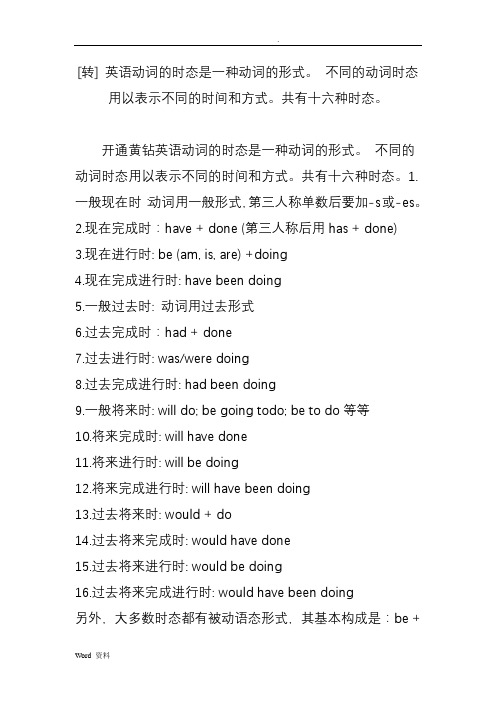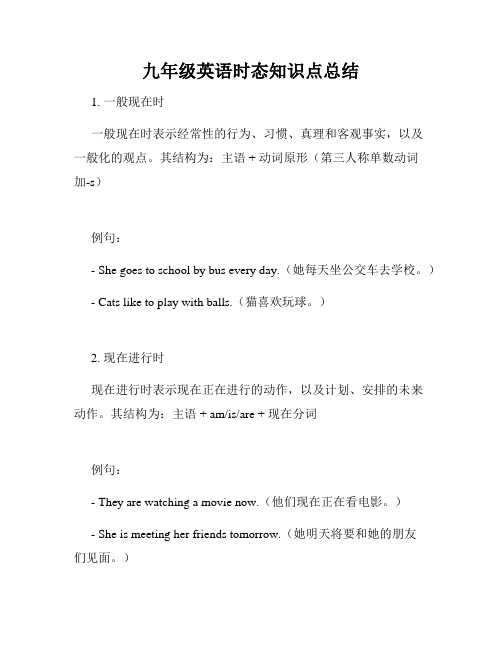英语动词时态_一般现在时_第三人称单数形式
- 格式:doc
- 大小:102.50 KB
- 文档页数:5

一般现在时态概念表示经常、反复、习惯性的动作或行为,也表示现存状况或客观真理。
结构主语+be动词、行为动词等句型I)当主语是第三人称单数时(he /she /it)肯定句单三主语+单三谓语+……He likes English.否定句单三主语+doesn't + 动词原形+……He doesn't likes English. 一般疑问句Does + 单三主语+ 动词原形+…… ?Does he likes English?肯定回答Yes , 单三主语+does Yes , he does.否定回答No , 单三主语+doesn't No , he doesn't.特殊疑问句疑问词+ 一般疑问句What does he like?特殊疑问句回答整句或关键词He likes English.II)当主语是其他人称时(I /we /you /you /they) 肯定句其他主语+ 动词原形+……They like English.其他主语+don't + 动词原形+……They don't likes English.否定句Do + 其他主语+ 动词原形+……?Do they like English?一般疑问句Yes , 其他主语+ do Yes , they do.肯定回答No , 其他主语+ don't No , they don't.否定回答疑问词+ 一般疑问句What do they like?特殊疑问句整句或关键词They like English.特殊疑问句回答表示现在正在进行的动作或行为。
概念结构be动词+现在分词句型肯定句主语+be+现在分词+……He is reading English.否定句主语+be not +现在分词+……He isn't reading English.一般疑问句Be + 主语+现在分词+……? Is he reading English?肯定回答Yes , 主语+be Yes , he is.否定回答No , 主语+be not No , he isn't.特殊疑问句疑问词+ 一般疑问句What is reading?特殊疑问句回答整句或关键词He is reading English. /English.概念表示将来某个时间将要发生的动作或存在的状态,也表示将来经常或重复发生的动作。

[转] 英语动词的时态是一种动词的形式。
不同的动词时态用以表示不同的时间和方式。
共有十六种时态。
开通黄钻英语动词的时态是一种动词的形式。
不同的动词时态用以表示不同的时间和方式。
共有十六种时态。
1.一般现在时:动词用一般形式,第三人称单数后要加-s或-es。
2.现在完成时:have + done (第三人称后用has + done)3.现在进行时: be (am, is, are) +doing4.现在完成进行时: have been doing5.一般过去时: 动词用过去形式6.过去完成时:had + done7.过去进行时: was/were doing8.过去完成进行时: had been doing9.一般将来时: will do; be going todo; be to do等等10.将来完成时: will have done11.将来进行时: will be doing12.将来完成进行时: will have been doing13.过去将来时: would + do14.过去将来完成时: would have done15.过去将来进行时: would be doing16.过去将来完成进行时: would have been doing另外,大多数时态都有被动语态形式,其基本构成是:be +done(过去分词)1.一般现在时:be (am, is, are) + done2.现在完成时:have/has been done3.现在进行时: be (am, is, are) +being done4.一般过去时: was/ were done5.过去完成时:had been done6.过去进行时: was/were being done7.一般将来时: will be done; be goingto be done; be to be done等等8.将来完成时: will have been done9.过去将来时: would be done10.过去将来完成时: would have been done一般现在时:一般现在时表示经常发生的习惯性的动作或目前所处的状态。

一般现在时态概念表示经常、反复、习惯性的动作或行为,也表示现存状况或客观真理。
结构主语+be动词、行为动词等句型I)当主语是第三人称单数时(he /she /it)肯定句单三主语+单三谓语+……He likes English.否定句单三主语+doesn't + 动词原形+……He doesn't likes English. 一般疑问句Does + 单三主语+ 动词原形+…… ?Does he likes English?肯定回答Yes , 单三主语+does Y es , he does.否定回答No , 单三主语+doesn't No , he doesn't.特殊疑问句疑问词+ 一般疑问句What does he like?特殊疑问句回答整句或关键词He likes English.II)当主语是其他人称时(I /we /you /you /they) 肯定句其他主语+ 动词原形+……They like English.否定句其他主语+don't + 动词原形+……They don't likes English. 一般疑问句Do + 其他主语+ 动词原形+……?Do they like English?肯定回答Yes , 其他主语+ do Y es , they do.否定回答No , 其他主语+ don't No , they don't.特殊疑问句疑问词+ 一般疑问句What do they like?特殊疑问句回答整句或关键词They like English.概念表示现在正在进行的动作或行为。
结构be动词+现在分词句型肯定句主语+be+现在分词+……He is reading English.否定句主语+be not +现在分词+……He isn't reading English.一般疑问句Be + 主语+现在分词+……? Is he reading English?肯定回答Yes , 主语+be Y es , he is.否定回答No , 主语+be not No , he isn't.特殊疑问句疑问词+ 一般疑问句What is reading?特殊疑问句回答整句或关键词He is reading English. /English.概念表示将来某个时间将要发生的动作或存在的状态,也表示将来经常或重复发生的动作。

九年级英语时态知识点总结1. 一般现在时一般现在时表示经常性的行为、习惯、真理和客观事实,以及一般化的观点。
其结构为:主语 + 动词原形(第三人称单数动词加-s)例句:- She goes to school by bus every day.(她每天坐公交车去学校。
)- Cats like to play with balls.(猫喜欢玩球。
)2. 现在进行时现在进行时表示现在正在进行的动作,以及计划、安排的未来动作。
其结构为:主语 + am/is/are + 现在分词例句:- They are watching a movie now.(他们现在正在看电影。
)- She is meeting her friends tomorrow.(她明天将要和她的朋友们见面。
)3. 一般过去时一般过去时表示过去发生的动作或状态。
其结构为:主语 + 动词过去式例句:- We went to the beach last summer.(我们去年夏天去了海滩。
)- He studied hard for the test.(他为了考试努力学习。
)4. 过去进行时过去进行时表示过去某个时间段正在进行的动作。
其结构为:主语 + was/were + 现在分词例句:- They were playing soccer when it started raining.(下雨时他们正在踢足球。
)- I was studying in the library yesterday afternoon.(昨天下午我在图书馆学习。
)5. 一般将来时一般将来时表示将来某个时间要发生的动作。
其结构为:主语+ will + 动词原形例句:- We will have a party next week.(我们下周要开派对。
)- She will visit her grandparents this weekend.(她这个周末要去看望她的祖父母。


一般现在时态一、一般现在时的用法:1.表示经常或者反复发生的动作. 如: 我每天吃午饭. I have lunch every day.2.还表示现在存在的一种状态. 如:我姐姐是一位老师.My sister is a teacher.3.客观真理,客观存在,科学事实。
例如:The earth moves around the sun.地球绕着太阳转。
二、一般现在时态时间状语:经常与often(经常)sometimes(有时)always(总是)usually(通常)等频度副词连用(位于系动词之后,行为动词之前。
),也经常与every day (每天), every week(每周), every month(每月), every term(每学期), every year (每年), once a week (一周一次),twice a year(一年两次)等时间状语连用。
三、一般现在时第三人称单数问题一般现在时中,当主语是第三人称单数时,谓语动词要用第三人称单数形式,即常在动词原形后加-s或-es。
但有些同学们对于哪些主语是第三人称单数还不十分清楚,现归纳总结如下:1.人称代词he, she, it是第三人称单数。
如: He likes watching TV.他喜欢看电视。
She has lunch at twelve.她十二点吃午餐。
It looks like a cat.它看起来像只猫。
2.单个人名、地名或称呼作主语;是第三人称单数。
如:①Han Mei looks like her mother.韩梅看起来像她的母亲。
②Beijing is in China.北京在中国。
③Uncle Wang often makes c akes.王叔叔经常做蛋糕。
3.单数可数名词或"this / that / the/ a +单数可数名词"作主语时,是第三人称单数。
如:①A horse is a useful animal.马是有用的动物。
英语七年级下册人教版一般将来时和一般现在时两种时态笔记概念构成动词形式1.一般现在时(1)结构:当主语是第三人称单数时,谓语动词用第三人称单数形式。
(2)动词的第三人称单数形式变化规则如下:①直接加s。
如:work-works。
②以“辅音字母+y”结尾的词,先变y为i,再加es。
如:carry-carries;cry-cries;try-tries;study一studies。
③以s,x,o,ch,sh结尾的词加es。
如:wash-washes;teach-teaches;go-goes;pass一passes;fix-fixes。
④特殊:have has;am/are is(3)用法:①表示习惯性的动作。
常与seldom,often,usually,always,sometimes,today,every day,once a week,every five minutes,on Sundays等时间状语连用。
如:I go to school at seven every day.我每天七点去上学。
②表示普遍真理和客观事实。
如:The earth goes around the sun.地球绕着太阳转。
③表示在现里所发生的一个动作。
如:Here comes the bus.公共汽车来了。
④在时间和条件状语从句中代替一般将来时。
如:I'll go shopping with my mother if sheis free tomorrow.如果明天我妈妈有空,我将和她去购物。
3.一般将来时(1)结构:助动词shall/will+动词原形;be going to+动词原形(2)用法:①表示将要发生的动作或状态,常用的时间状语有later(on),soon,in a month(in+时间段),next time,from now on,tomorrow等。
如:I shall be eighteen years old next year.明年我就18岁了。
一、概述一般现在时的概念和用法:(1)表示现阶段经常、反复、习惯性的动作;(2)表示目前的状况;(3)表示自然界的客观真理。
二、一般现在时的结构时态的结构指的是动词的变化形式。
一般现在时间有两种结构,一种是动词原形,用于主语为非第三人称时的情况;另一种为动词的第三人称单数形式,用于主语为第三人称时的情况。
Eg1. We often get up early in the morning.Eg2. My father often gets up early in the morning.三、谈谈“主语为三单,其后动词s添”在一般现在时中,当主语为第三人称单数时,谓语动词要用第三人称单数形式。
可以简单叙述为“主语为三单,其后动词s添”。
何谓第三人称单数?用一句话概括就是“非你、非我、非复数”,如he, she, it, my father, my mother, my sister, our English teacher, Tom, Mike, Liu Jia, China, my book, etc.Eg3.He sometimes goes to school by bike.Eg4.My father works in the hospital as a doctor.四、一般现在时的肯定句中,主语为第三人称单数的动词变化主要体现在词尾的变化上,其规律为:(与名词变成复数的变法大致相同。
)五、一般现在时的句子转换(1)当句子中有be动词或情态动词时,则把be动词或情态动词(can,could等等)提到主语的前面变成一般疑问句;在be动词或情态动词后面加not变成否定句.例:①陈述句:She is a student.一般疑问句→ Is she a student?否定句→ She is not a student.②陈述句:I can swim.一般疑问句→ Can you swim否定句→ I can not swim.(2)当句子中即没有be动词,也没有情态动词时,则在主语前加助动词do (you,以及复数), does(单数she,he,it)变成一般疑问句;在主语后谓语动词前加助动词don’t(I,you,以及复数), doesn’t(单数she,he,it)变成否定句,助动词后的动词要变成动词原形。
一般现在时三单的语法一般现在时是英语中最基本的时态之一,也是使用最广泛的时态之一。
在一般现在时中,动词的变化规律与第三人称单数的主语有关。
下面将解析一般现在时三单的语法。
一般现在时的定义一般现在时表示的是当前的状态、经常性的事情或者客观事实。
它可以与日常生活、常识和常见现象有关。
例句如下:1. He usually drinks coffee in the morning.2. Her parents live in the countryside.3. The sun rises in the east.一般现在时的构成一般现在时的结构是主语 + 动词原形,例如:1. I play football every Saturday.2. She reads a lot of books.3. They like singing and dancing.在第三人称单数形式中,动词要加 -s, -es或 -ies.当动词以辅音加 y 结尾时,通常将 y 改为 i ,在加 es,例如:study – studies,try – tries.动词以 s, x , z, ch 或 sh 结尾时,加 es,例如:watch –watches,fix – fixes.动词以 oo 结尾时,加 es,例如:do – does.特殊情况当动词以元音字母加 y 结尾时,只需加 s,例如:play –plays,enjoy – enjoys常见的不合常规的第三人称单数形式包括:1. be – is2. have – has3. do – does4. go – goes5. can – can6. say – says7. want – wants8. need – needs9. like – likes例如:1. She is a doctor.2. He has a dog.3. John goes to school early.4. She can speak Spanish.5. The cat likes milk.6. He wants to go to the beach.总结学好一般现在时的第三人称单数变化非常重要,因为这种形式在日常英语中非常普遍。
一般现在时中的第三人称单数形式在一般现在时中,当主语是第三人称单数时,谓语动词要用第三人称单数形式,即常在动词原形后加-s或—es。
(一)什么是一般现在时?一般现在时的基本用法有哪些呢?【一般现在时的功能】1.表示事物或人物的特征、状态。
如:The sky is blue.天空是蓝色的。
2。
表示经常性或习惯性的动作。
如:I get up at six every day。
我每天六点起床。
3。
表示客观现实。
如:The earth goes around the sun.地球绕着太阳转.(二)哪些主语是第三人称单数?现归纳总结如下:一、人称代词he, she, it是第三人称单数.如:He likes watching TV。
他喜欢看电视。
She has lunch at twelve。
她十二点吃午餐.It looks like a cat。
它看起来像只猫.二、单个人名、地名或称呼作主语;是第三人称单数.如:①Tom looks like her mother。
韩梅看起来像她的母亲.②Beijing is in China. 北京在中国.③Uncle Wang often makes cakes. 王叔叔经常做蛋糕。
三、单数可数名词或"this / that / the+单数可数名词"作主语时,是第三人称单。
如:①A horse is a useful animal. 马是有用的动物。
②This book is yours. 这本书是你的.③That car is red. 那辆小汽车是红色的.④The cat is Lucy's. 这只猫是露茜的.四、不定代词someone, somebody, nobody, everything, something等及指示代词this, that 作主语时,是第三人称单数。
如:①Everyone is here. 大家到齐了.②There is something wrong with the watch。
一般现在时态概念表示经常、反复、习惯性的动作或行为,也表示现存状况或客观真理。
结构主语+be动词、行为动词等
句型
I)当主语是第三人称单数时(he /she /it)
肯定句单三主语+单三谓语+……He likes English.
否定句单三主语+doesn't + 动词原形d +……He doesn't likes English.
一般疑问句Does + 单三主语+ 动词原形+…… ?Does he likes English?
肯定回答Yes , 单三主语+does Yes , he does.
否定回答No , 单三主语+doesn't No , he doesn't.
特殊疑问句疑问词+ 一般疑问句What does he like?
特殊疑问句回答整句或关键词He likes English.
II)当主语是其他人称时(I /we /you /you /they) 肯定句其他主语+ 动词原形+……They like English.
否定句其他主语+don't + 动词原形+……They don't likes English.
一般疑问句Do + 其他主语+ 动词原形+……?Do they like English?
肯定回答Yes , 其他主语+ do Yes , they do.
否定回答No , 其他主语+ don't No , they don't.
特殊疑问句疑问词+ 一般疑问句What do they like?
特殊疑问句回答整句或关键词They like English.
概念表示现在正在进行的动作或行为。
结构be动词+现在分词
句型
肯定句主语+be+现在分词+……He is reading English.
否定句主语+be not +现在分词+……He isn't reading English.
一般疑问句Be + 主语+现在分词+……? Is he reading English?
肯定回答Yes , 主语+be Yes , he is.
否定回答No , 主语+be not No , he isn't.
特殊疑问句疑问词+ 一般疑问句What is reading?
特殊疑问句回答整句或关键词He is reading English. /English.
概念表示将来某个时间将要发生的动作或存在的状态,也表示将来经常或重复发生的动作。
结构1:be going to+ 动词原形+……
2: will + 动词原形+……
句型
肯定句1:主语+be going to+ 动词原形+……
2:主语+ will + 动词原形+……
1:They are going to buy a car next year.
2:He will be at home tomorrow.
否定句1:主语+be not going to+ 动词原形+……
2:主语+ will not(won't)+ 动词原形+……
1:They aren't going to buy a car next year.
2:He won't be at home tomorrow.
一般疑问句1:Be + 主语+going to +动词原形+……?
2:Will + 主语+ 动词原形+……?
1: Are they going to buy a car next year?
2:Will he be at home tomorrow?
肯定回答1:Yes , 主语+ be 2:Yes , 主语+will 1:Yes , they are. 2:Yes , he will.
否定回答1:No , 主语+be not 2:No , 主语+will not 1:No , they aren't. 2:No , he won't.
特殊疑问句疑问词+ 一般疑问句1: When are they going to buy a car?
2:Where will he be tomorrow?
特殊疑问句回答整句或关键词1:They are going to buy a car next year. /Next year.
2:He will be at home tomorrow. /Tomorrow.
概念表示过去发生的动作或行为对现在造成的影响或后果,也表示过去发生的动作或行为一直持续到现在,而且还有可能持续下去。
结构have /has +过去分词
句型
肯定句主语+ have /has +过去分词+ ……We have had a party in my home.
否定句主语+haven't /hasn't+过去分词+……We haven't had a party in my home.
一般疑问句Have /Has +主语+过去分词+……? Have we had a party in my home?
肯定回答Yes , 主语+have /has Yes , you have.
否定回答No , 主语+haven't /hasn't No , you haven't.
特殊疑问句疑问词+ 一般疑问句Where have you had a party ?
特殊疑问句回答整句或关键词We have had a party in my home. /Home.
概念表示过去某个时间里发生的动作或状态,也表示过去习惯性、经常性的动作、行为、结构主语+ 动词过去式
句型
I)当谓语是be动词时(was /were )
肯定句He /She /It /I+ was+ ……We /You/You/They + were……He was at home yesterday. They were ill last night. 否定句He /She /It /I+ wasn't + ……
We /You/You/They + weren't+……
He wasn't at home yesterday.
They weren't ill last night.
一般疑问
句
Was+he /she /it/I+ ……?
Were+we /you /you /they+ ……?
Was he at home yesterday?
Were they ill last night?
肯定回答Yes , he /she /it/I+ was Yes , we /you /you /they+ were Yes , he was. Yes , they were.
否定回答No , he /she /it/I+ wasn't No , we /you /you /they+ weren't No , he wasn't. No , they weren't.
特殊疑问
句
疑问词+ 一般疑问句Where was he yesterday? When were they ill?
特殊疑问
句回答
整句或关键词He was at home./At Home.
II)当谓语是行为动词时
肯定句主语+ 过去式+ ……He went to Beijing yesterday.
否定句主语+ didn't + 动词原形+ ……He didn't go to Beijing yesterday.
一般疑问句Did + 主语+ 动词原形+ ……? Did he go to Beijing yesterday?
肯定回答Yes , 主语+ did Yes , he did.
否定回答No , 主语+ didn't No , he didn't.
特殊疑问句疑问词+ 一般疑问句Where did he go to yesterday?
特殊疑问句回答整句或关键词He went to Beijing. / Beijing.。